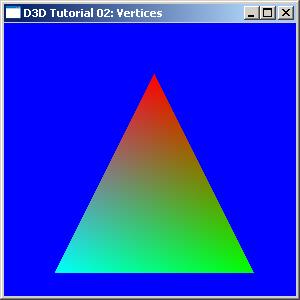术语:
FVF (flexible vertex format) 灵活的顶点格式

//-----------------------------------------------------------------------------
// File: Vertices.cpp
//
// Desc: In this tutorial, we are rendering some vertices. This introduces the
// concept of the vertex buffer, a Direct3D object used to store
// vertices. Vertices can be defined any way we want by defining a
// custom structure and a custom FVF (flexible vertex format). In this
// tutorial, we are using vertices that are transformed (meaning they
// are already in 2D window coordinates) and lit (meaning we are not
// using Direct3D lighting, but are supplying our own colors).
//
// Copyright (c) Microsoft Corporation. All rights reserved.
//-----------------------------------------------------------------------------
#include <d3d9.h>
#pragma warning( disable : 4996 ) // disable deprecated warning
#include <strsafe.h>
#pragma warning( default : 4996 )
//-----------------------------------------------------------------------------
// Global variables
//-----------------------------------------------------------------------------
LPDIRECT3D9 g_pD3D = NULL; // Used to create the D3DDevice
LPDIRECT3DDEVICE9 g_pd3dDevice = NULL; // Our rendering device
LPDIRECT3DVERTEXBUFFER9 g_pVB = NULL; // Buffer to hold vertices 顶点Buffer
// A structure for our custom vertex type 自定义顶点类型
struct CUSTOMVERTEX
{
FLOAT x, y, z, rhw; // The transformed position for the vertex
DWORD color; // The vertex color
};
// Our custom FVF, which describes our custom vertex structure
#define D3DFVF_CUSTOMVERTEX (D3DFVF_XYZRHW|D3DFVF_DIFFUSE)
//-----------------------------------------------------------------------------
// Name: InitD3D()
// Desc: Initializes Direct3D
//-----------------------------------------------------------------------------
HRESULT InitD3D( HWND hWnd )
{
// Create the D3D object.
if( NULL == ( g_pD3D = Direct3DCreate9( D3D_SDK_VERSION ) ) )
return E_FAIL;
// Set up the structure used to create the D3DDevice
D3DPRESENT_PARAMETERS d3dpp;
ZeroMemory( &d3dpp, sizeof(d3dpp) );
d3dpp.Windowed = TRUE;
d3dpp.SwapEffect = D3DSWAPEFFECT_DISCARD;
d3dpp.BackBufferFormat = D3DFMT_UNKNOWN;
// Create the D3DDevice
if( FAILED( g_pD3D->CreateDevice( D3DADAPTER_DEFAULT, D3DDEVTYPE_HAL, hWnd,
D3DCREATE_SOFTWARE_VERTEXPROCESSING,
&d3dpp, &g_pd3dDevice ) ) )
{
return E_FAIL;
}
// Device state would normally be set here
return S_OK;
}
//-----------------------------------------------------------------------------
// Name: InitVB()
// Desc: Creates a vertex buffer and fills it with our vertices. The vertex
// buffer is basically just a chuck of memory that holds vertices. After
// creating it, we must Lock()/Unlock() it to fill it. For indices, D3D
// also uses index buffers. The special thing about vertex and index
// buffers is that they can be created in device memory, allowing some
// cards to process them in hardware, resulting in a dramatic
// performance gain.
//-----------------------------------------------------------------------------
HRESULT InitVB()
{
// Initialize three vertices for rendering a triangle 初始化要渲染的三角形的三个顶点
CUSTOMVERTEX vertices[] =
{
{ 150.0f, 50.0f, 0.5f, 1.0f, 0xffff0000, }, // x, y, z, rhw, color
{ 250.0f, 250.0f, 0.5f, 1.0f, 0xff00ff00, },
{ 50.0f, 250.0f, 0.5f, 1.0f, 0xff00ffff, },
};
// Create the vertex buffer. 创建vertex buffer
// Here we are allocating enough memory
// (from the default pool) to hold all our 3 custom vertices. We also
// specify the FVF, so the vertex buffer knows what data it contains.
if( FAILED( g_pd3dDevice->CreateVertexBuffer( 3*sizeof(CUSTOMVERTEX),
0, D3DFVF_CUSTOMVERTEX,
D3DPOOL_DEFAULT, &g_pVB, NULL ) ) )
{
return E_FAIL;
}
// Now we fill the vertex buffer. 填充vertex buffer
// To do this, we need to Lock() the VB to
// gain access to the vertices. This mechanism is required becuase vertex
// buffers may be in device memory.
VOID* pVertices; // 输出参数
if( FAILED( g_pVB->Lock( 0, sizeof(vertices), (void**)&pVertices, 0 ) ) )
return E_FAIL;
memcpy( pVertices, vertices, sizeof(vertices) );
g_pVB->Unlock();
return S_OK;
}
//-----------------------------------------------------------------------------
// Name: Cleanup()
// Desc: Releases all previously initialized objects
//-----------------------------------------------------------------------------
VOID Cleanup()
{
if( g_pVB != NULL )
g_pVB->Release();
if( g_pd3dDevice != NULL )
g_pd3dDevice->Release();
if( g_pD3D != NULL )
g_pD3D->Release();
}
//-----------------------------------------------------------------------------
// Name: Render()
// Desc: Draws the scene
//-----------------------------------------------------------------------------
VOID Render()
{
// Clear the backbuffer to a blue color
g_pd3dDevice->Clear( 0, NULL, D3DCLEAR_TARGET, D3DCOLOR_XRGB(0,0,255), 1.0f, 0 );
// Begin the scene
if( SUCCEEDED( g_pd3dDevice->BeginScene() ) )
{
// Draw the triangles in the vertex buffer. 画vertex buffer中的三角形
// This is broken into a few steps.
// We are passing the vertices down a "stream", so first we need
// to specify the source of that stream, which is our vertex buffer.
// 我们正传递顶点到一个“流”里,这个流的源头是vertex buffer
g_pd3dDevice->SetStreamSource( 0, g_pVB, 0, sizeof(CUSTOMVERTEX) );
// Then we need to let D3D know what vertex shader to use.
// 让D3D知道我们用什么vertex shader
// Full, custom vertex shaders are an advanced topic,
// but in most cases the vertex shader is just the FVF,
// so that D3D knows what type of vertices we are dealing with.
g_pd3dDevice->SetFVF( D3DFVF_CUSTOMVERTEX );
// Finally, we call DrawPrimitive() which does the actual rendering
// of our geometry (in this case, just one triangle).
g_pd3dDevice->DrawPrimitive( D3DPT_TRIANGLELIST, 0, 1 );
// End the scene
g_pd3dDevice->EndScene();
}
// Present the backbuffer contents to the display
g_pd3dDevice->Present( NULL, NULL, NULL, NULL );
}
//-----------------------------------------------------------------------------
// Name: MsgProc()
// Desc: The window's message handler
//-----------------------------------------------------------------------------
LRESULT WINAPI MsgProc( HWND hWnd, UINT msg, WPARAM wParam, LPARAM lParam )
{
switch( msg )
{
case WM_DESTROY:
Cleanup();
PostQuitMessage( 0 );
return 0;
}
return DefWindowProc( hWnd, msg, wParam, lParam );
}
//-----------------------------------------------------------------------------
// Name: WinMain()
// Desc: The application's entry point
//-----------------------------------------------------------------------------
INT WINAPI WinMain( HINSTANCE hInst, HINSTANCE, LPSTR, INT )
{
// Register the window class
WNDCLASSEX wc = { sizeof(WNDCLASSEX), CS_CLASSDC, MsgProc, 0L, 0L,
GetModuleHandle(NULL), NULL, NULL, NULL, NULL,
"D3D Tutorial", NULL };
RegisterClassEx( &wc );
// Create the application's window
HWND hWnd = CreateWindow( "D3D Tutorial", "D3D Tutorial 02: Vertices",
WS_OVERLAPPEDWINDOW, 100, 100, 300, 300,
NULL, NULL, wc.hInstance, NULL );
// Initialize Direct3D
if( SUCCEEDED( InitD3D( hWnd ) ) )
{
// Create the vertex buffer
if( SUCCEEDED( InitVB() ) )
{
// Show the window
ShowWindow( hWnd, SW_SHOWDEFAULT );
UpdateWindow( hWnd );
// Enter the message loop
MSG msg;
ZeroMemory( &msg, sizeof(msg) );
while( msg.message!=WM_QUIT )
{
if( PeekMessage( &msg, NULL, 0U, 0U, PM_REMOVE ) )
{
TranslateMessage( &msg );
DispatchMessage( &msg );
}
else
Render();
}
}
}
UnregisterClass( "D3D Tutorial", wc.hInstance );
return 0;
}
posted on 2007-02-15 22:16
七星重剑 阅读(979)
评论(0) 编辑 收藏 引用 所属分类:
Game Graphics